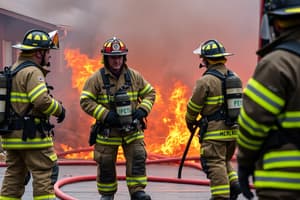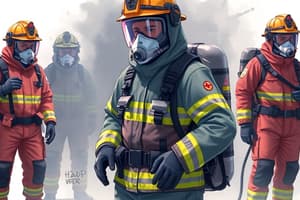Podcast
Questions and Answers
What was the only known similarity among the structure fires examined in the disorientation study?
What was the only known similarity among the structure fires examined in the disorientation study?
- The fires all occurred in commercial structures
- The fires were all of the same construction type
- The firefighters became confused or disoriented in each incident (correct)
- The structures were all built during a specific era
How many different types of occupancies were represented among the structures in which disorientation occurred?
How many different types of occupancies were represented among the structures in which disorientation occurred?
- 4
- 7
- 6 (correct)
- 5
What was the most common construction type among the structures in which disorientation occurred?
What was the most common construction type among the structures in which disorientation occurred?
- Protected wood-frame construction
- Heavy timber construction
- Unprotected noncombustible construction (correct)
- Fire-resistive construction
What was the range of sizes for the structures in which disorientation occurred?
What was the range of sizes for the structures in which disorientation occurred?
What percentage of the structures had an enclosed design?
What percentage of the structures had an enclosed design?
How many buildings were involved in the structural analysis?
How many buildings were involved in the structural analysis?
What percentage of cases experienced prolonged zero visibility conditions (PZVCs)?
What percentage of cases experienced prolonged zero visibility conditions (PZVCs)?
How many buildings were unoccupied during the fire?
How many buildings were unoccupied during the fire?
What caused confusion and injuries in 100% of the cases?
What caused confusion and injuries in 100% of the cases?
What type of building was thought to be occupied but was vacant?
What type of building was thought to be occupied but was vacant?
What did arriving firefighters encounter in 94% of the cases?
What did arriving firefighters encounter in 94% of the cases?
What caused the loss of company integrity in 100% of the cases?
What caused the loss of company integrity in 100% of the cases?
In what percentage of cases did disorientation incidents continue to occur nationally?
In what percentage of cases did disorientation incidents continue to occur nationally?
What caused disorientation in 65% of the cases examined?
What caused disorientation in 65% of the cases examined?
What percentage of structures lacked a functioning sprinkler system?
What percentage of structures lacked a functioning sprinkler system?
What rendered activating sprinkler heads ineffective in one incident?
What rendered activating sprinkler heads ineffective in one incident?
In how many incidents did disorientation occur within the structures at various distances measured from the point of entry?
In how many incidents did disorientation occur within the structures at various distances measured from the point of entry?
What caused disorientation in all of the incidents examined during the study period?
What caused disorientation in all of the incidents examined during the study period?
"Blinding soup" that covered personal protective equipment was created by:
"Blinding soup" that covered personal protective equipment was created by:
What percentage of firefighters experienced disorientation for sustained periods of time?
What percentage of firefighters experienced disorientation for sustained periods of time?
How many additional disorientation sequences were identified following a review of cases included in the U.S. Fire Administration's 'U.S. Firefighter Fatality Retrospective Study'?
How many additional disorientation sequences were identified following a review of cases included in the U.S. Fire Administration's 'U.S. Firefighter Fatality Retrospective Study'?
Flashcards are hidden until you start studying
Study Notes
- The structural analysis involved 17 buildings, including a 20-year-old single-family dwelling, a thrift store built in the 1940s, and a 98-year-old warehouse built in 1905.
- Half of the structures were occupied during the fire, half were unoccupied, and one was vacant, despite being thought to be occupied.
- Disorientation occurred in structures with various sizes, heights, types of occupancy, and construction.
- Structure analysis revealed that 100% of the structures had an enclosed design.
- Arriving firefighters encountered smoke conditions ranging from nothing to heavy densities in 94% of the cases.
- In all cases, firefighters initiated an aggressive interior attack to locate and extinguish the fire.
- Prolonged zero visibility conditions (PZVCs) occurred in 100% of the cases.
- Handline separation or entangled handlines were experienced in 100% of the cases, causing confusion and injuries.
- Company integrity was lost in 100% of the cases, often due to the force of flashovers or backdrafts.
- During the course of the study, disorientation incidents continued to occur nationally in enclosed structures and spaces, highlighting the significance of these findings.
Studying That Suits You
Use AI to generate personalized quizzes and flashcards to suit your learning preferences.




